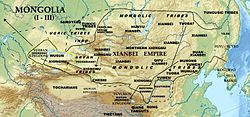Xianbei state
| Xianbei state | ||||||||||||||||
| Sianbi | ||||||||||||||||
| Nomadic empire | ||||||||||||||||
|
||||||||||||||||
|
The Xianbei state at its maximum extent
|
||||||||||||||||
| Capital | Near the Orkhon River, Mongolia | |||||||||||||||
| Languages | Xianbei | |||||||||||||||
| Religion | Shamanism | |||||||||||||||
| Government | Monarchy | |||||||||||||||
| Historical era | Antiquity | |||||||||||||||
| • | Established | 93? | ||||||||||||||
| • | Disestablished | 234 | ||||||||||||||
|
||||||||||||||||
| Today part of |
|
|||||||||||||||
The Xianbei state or Xianbei confederation was a nomadic empire which existed in modern-day Mongolia, Inner Mongolia, northern Xinjiang, Northeast China, Gansu, Buryatia, Zabaykalsky Krai, Irkutsk Oblast, Tuva, Altai Republic and eastern Kazakhstan from 156-234. Like most ancient peoples known through Chinese historiography, the ethnic makeup of the Xianbei is unclear. The Xianbei were a northern branch of the earlier Proto-Mongolic Donghu.
After the downfall of the Xiongnu, the Xianbei, who were a northern branch of the Donghu, established domination in Mongolia starting from 93 CE.
[F]rom the middle of the first century, the nomadic tribes that replaced the Xiongnu in Mongolia were collectively called the Xianbei. ... It should be pointed out that the names of the various peoples, or subdivisions of peoples, who came into China at this time do not indicate distinct ethnicities.
The Xianbei state reached their height under the rule of the khagan Tanshihuai (141–181).
Tanshihuai of the Xianbei divided his territory into three sections: the eastern, the middle and the western. From the You Beiping to the Liao River, connecting the Fuyu and Mo to the east, it was the eastern section. There were more than twenty counties. The darens (chiefs) (of this section) were called Mijia, Queji, Suli and Huaitou. From the You Beiping to Shanggu to the west, it was the middle section. There were more than ten counties. The darens of this section were called Kezui, Queju, Murong, et al. From Shanggu to Dunhuang, connecting the Wusun to the west, it was the western section. There were more than twenty counties. The darens (of this section) were called Zhijian Luoluo, Rilü Tuiyan, Yanliyou, et al. These chiefs were all subordinate to Tanshihuai.
Uneasiness at the Han court about this development of a new power on the steppes finally ushered in a campaign on the northern border to annihilate the confederacy once and for all. In 177, 30,000 Han cavalry attacked the confederacy, commanded by Xia Yu (夏育), Tian Yan (田晏) and Zang Min (臧旻), each of whom was the commander of units sent respectively against the Wuhuan, the Qiang, and the Southern Xiongnu before the campaign. Each military officer commanded 10,000 cavalrymen and advanced north on three different routes, aiming at each of the three federations. Cavalry units commanded by chieftains of each of the three federations almost annihilated the invading forces. Eighty percent of the troops were killed and the three officers, who only brought tens of men safely back, were relieved from their posts. A Han memorial submitted in 177 states:
...
Wikipedia

